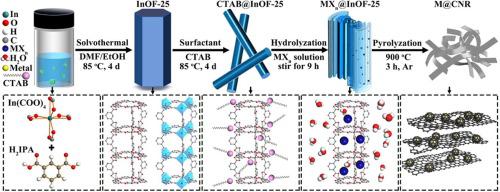Chemical Engineering Journal ( IF 13.3 ) Pub Date : 2021-05-18 , DOI: 10.1016/j.cej.2021.130336 Qi Huang , Yuanyuan Guo , Dandan Chen , Linjie Zhang , Ting-Ting Li , Yue Hu , Jinjie Qian , Shaoming Huang

|
In pursuit of sustainable and eco-friendly energy output, fuel cells are well-recognized as the most promising candidates in clean energy conversion and storage technology. Noble metal-based nanomaterials have long been regarded as the most efficient electrocatalysts for the oxygen reduction reaction (ORR) in terms of activity, selectivity, and stability. Here, we propose a self-template strategy where a type of hexagonal tubular InOF-25 could be tuned by adding a different amount of surfactants. Owing to the suitable pore size, these fabricated X-CTAB@InOF-25 (X = 50–300) series are used as precursors to encapsulate a series of discrete metal complexes, including Ag(NH3)2+, AuCl4-, PdCl42-, and PtCl62-. Then, the as-prepared carbon nanoribbons doped with precious metals (M@CNR, M = Pd, Pt, Ag, Au) exhibit good performance in the electrocatalytic ORR as well as Zn-air battery due to their large surface area, rich active sites, and extremely active noble metal nanoparticles. Among them, the most optimal Pd@CNR shows an onset potential of 0.94 V vs. RHE, high diffusion-limited current density of 5.87 mA cm-2, small Tafel slope of 51.74 mV dec-1, and satisfying stability with current retention of 95.4% after 10 h. Meanwhile, these obtained M@CNR as cathode catalysts are modeled and proved by the theoretical calculation with strong oxygen adsorption for efficient ORR. In this context, the main issues, large overpotential required for ORR and fast degradation of the electrocatalysts, impair practical application, which could be relieved by the active noble metals well-protected by carbon nanomaterials from the rational design and preparation of precursors.
中文翻译:

在实用的碱性燃料电池中,通过有效地减少氧气,将超细贵金属合理地构建在碳纳米带上
在追求可持续和环保的能源输出方面,燃料电池被公认为清洁能源转换和存储技术中最有前途的候选者。就活性,选择性和稳定性而言,基于贵金属的纳米材料长期以来一直被认为是用于氧还原反应(ORR)的最有效的电催化剂。在这里,我们提出了一种自我模板策略,其中可以通过添加不同量的表面活性剂来调节六角形管状InOF-25。由于合适的孔径,这些制造X-CTAB @ InOF-25(X = 50-300)串联使用作为前体包封一系列离散的金属配合物,包含Ag(NH的3)2 +,AUCL 4 -,的PdCl 4 2 - ,和氯铂酸6 2 - 。然后,所制备的掺杂有贵金属(M @ CNR,M = Pd,Pt,Ag,Au)的碳纳米带由于其表面积大,活性高而在电催化ORR和锌空气电池中表现出良好的性能。部位和极活泼的贵金属纳米粒子。其中,最佳的Pd @ CNR的起始电位为0.94 Vvs。RHE,的5.87毫安厘米高扩散限制电流密度- 2,51.74毫伏分解的小塔菲尔斜率-1,并且满足稳定性10小时后95.4%的电流保持。同时,这些获得了M @ CNR作为阴极催化剂的模型,并通过理论计算与强氧吸附来证明有效的ORR。在这种情况下,主要问题,ORR所需的过大电势和电催化剂的快速降解会损害实际应用,而碳纳米材料充分保护的活性贵金属可通过合理设计和制备前体来缓解。











































 京公网安备 11010802027423号
京公网安备 11010802027423号